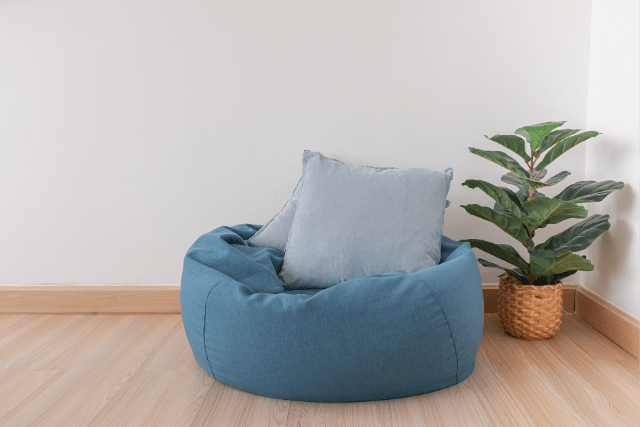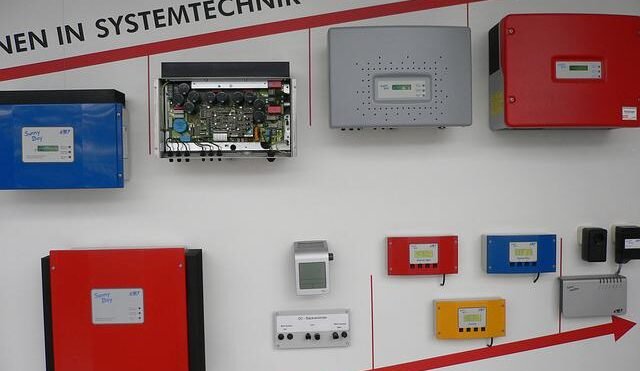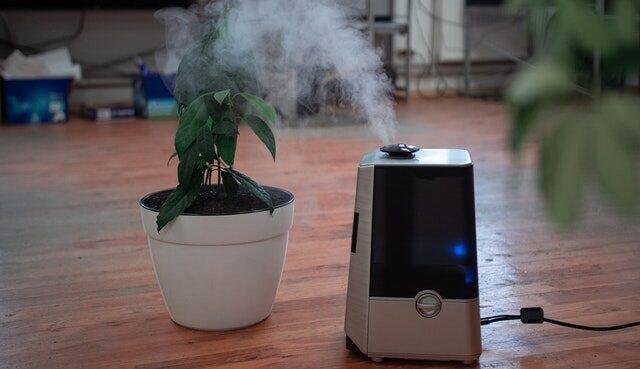Vacuum cleaners are the unsung heroes of a clean home, but their efficiency heavily depends on a small, often overlooked component – the filter. Whether a standard filter or a high-end HEPA filter, it is paramount to trapping dust allergens and maintaining clean air.
Key Takeaways
- Different types of vacuum filters (HEPA, foam, electrostatic) improve air quality and capture particles.
- Regularly cleaning and changing vacuum filters is important for maintaining optimal performance and prolonging the lifespan of the vacuum cleaner.
- Signs of dirty or clogged filters include reduced suction power, unpleasant odours, and visible dirt or debris on the filter.
- Cleaning and changing vacuum filters include checking the manufacturer’s instructions, removing the filter, cleaning it using appropriate methods, allowing it to dry completely, and replacing it if damaged or no longer effective.
Understanding Vacuum Cleaner Filters
Understanding vacuum filters is essential for maintaining optimal performance. Different types of vacuum filters, such as HEPA, foam, and electrostatic filters, play a crucial role in trapping dust and allergens. Regularly cleaning and changing these filters is important to ensure that the vacuum cleaner continues to remove dirt and maintain strong suction power effectively.
Different types of vacuum filters (e.g., HEPA, foam, electrostatic)
Different vacuum filters, such as HEPA, foam, and electrostatic filters, are crucial in maintaining optimal performance and improving indoor air quality.
Here are three common types of vacuum filters:
- HEPA filters are highly effective at trapping small particles and allergens, making them ideal for people with allergies or asthma. HEPA filters improve indoor air quality by capturing 99.97% of particles as small as 0.3 microns.
- Foam filters are designed to capture dust, dirt, debris, hair, and larger particles. They are washable and reusable, making them cost-effective and environmentally friendly. To clean a foam filter, soak it in hot water and gently scrub away the dirt.
- Electrostatic filters use static electricity to attract and trap charged particles, providing thorough filtration. They are effective at capturing fine dust and allergens. Electrostatic filters can be cleaned by gently tapping or rinsing them.
Regularly cleaning and changing vacuum filters, based on their type, ensures optimal performance and maintains clean indoor air quality.
How do filters work to trap dust and allergens?
Vacuum filters are crucial in maintaining optimal performance and improving indoor air quality by effectively trapping dust, dirt, and allergens from the air. These filters act as barriers, preventing particles from being released back into the air during vacuuming.
Different filters, such as HEPA, foam, and paper, are designed to capture specific sizes of particles. HEPA filters, for example, are highly efficient in trapping small particles, including allergens, pollen, and pet dander. To further illustrate how filters work, consider the following table:
| Filter Type | Particle Size Captured |
|---|---|
| HEPA | 0.3 microns and above |
| Foam | Large particles |
| Paper | Medium-sized particles |
Importance of regularly cleaning and changing filters
Regular maintenance of vacuum filters is crucial for ensuring optimal performance and extending the lifespan of the vacuum cleaner.
Here are three reasons why regularly cleaning and changing filters is important:
- Improved suction power: Dirty filters can become clogged with dust and debris, reducing the vacuum’s suction power. Regularly cleaning or changing the filter can maintain strong suction for effective dirt and debris pickup.
- Enhanced air quality: A clean vacuum filter helps to trap dust and allergens, preventing them from being released back into the air. This improves the air quality in your home and reduces the risk of allergies or respiratory issues.
- Prolonged lifespan: Clogged filters can strain the vacuum’s motor, leading to overheating and potential damage. Regularly cleaning or changing the filter can prevent blockages and ensure the vacuum operates at its best, extending its lifespan.

Signs of Dirty or Clogged Filters
Dirty or clogged filters can significantly impact the performance of a vacuum cleaner. Reduced suction power, an unpleasant odour, and visible dirt on the filter are common indicators that it need cleaning or replacement. Ignoring these signs can result in inefficient cleaning, poor air quality, and potential damage to the vacuum.
Common indicators of dirty filters
Reduced suction power and an unpleasant odour during vacuuming indicate that the filters may need cleaning or changing. Here are three signs that your vacuum filter might be dirty:
- Decreased suction power: When the filter becomes clogged with dirt and debris, it restricts the airflow and reduces the vacuum’s suction power. As a result, the vacuum may struggle to pick up dirt effectively.
- Unpleasant odour: A dirty filter can emit a musty or stale smell during vacuuming. This odour is caused by trapped dirt and bacteria in the filter, which can compromise the air quality in the room.
- Unusual noises: A clogged filter can cause the vacuum cleaner to produce strange sounds while operating. This is because the motor has to work harder to compensate for the reduced airflow, leading to increased noise levels.
Regularly cleaning or changing your vacuum filters will help maintain optimal performance, ensuring efficient dust and allergen removal while preventing unpleasant odours and reduced suction power.
How clogged filters can impact the overall performance of the vacuum cleaner
Clogged filters can significantly impact the overall performance of a vacuum cleaner, leading to reduced efficiency and compromised cleaning capabilities. When the filters are clogged with dirt and debris, the vacuum’s suction power greatly diminishes, resulting in poor dust and allergen removal.
This can leave behind a dirty and unclean surface, defeating the purpose of vacuuming. Moreover, clogged filters can cause the vacuum cleaner to work harder, increasing energy consumption and potential overheating.
The overall performance of the vacuum cleaner is compromised when the filters are not cleaned or changed regularly. Cleaning or changing the filters as the manufacturer recommends is important to maintain optimal performance. This ensures that the vacuum cleaner operates at its best, providing efficient cleaning and prolonging its lifespan.
Cleaning Vacuum Filters
Cleaning vacuum filters is crucial in maintaining a vacuum cleaner to ensure optimal performance. This process involves preparing for filter cleaning, cleaning foam and washable filters, and cleaning HEPA and disposable filters.
Preparing for Filter Cleaning
First of all, it is important to gather the necessary tools and materials. This includes warm water, mild dish soap, and any desired essential oils. Also, ensure that the vacuum cleaner is unplugged for safety purposes.
Gathering necessary tools and materials
Gathering the necessary tools and materials for the task is essential to clean and maintain vacuum filters properly.
Here are three items you will need:
- A soft-bristled brush or toothbrush will help you clean cartridge filters effectively without damaging them.
- Warm water and mild dish soap are necessary for cleaning foam filters, ensuring they are free from dirt and debris.
- You will need a large garbage can for emptying and cleaning reusable vacuum bags and maintaining efficiency.
Ensuring the vacuum cleaner is unplugged
Disconnect the vacuum cleaner from the power source to ensure safety before cleaning the vacuum filters. It is crucial to unplug the vacuum cleaner to prevent any accidents while handling the filter. Safety should always be a priority, so ensure the vacuum cleaner is completely disconnected from the power source.
Before cleaning the vacuum filter, double-check that the vacuum cleaner is not connected to any power outlet. Unplugging the vacuum cleaner is the first step to prepare for filter cleaning safely.
Cleaning Foam and Washable Filters
Cleaning foam and washable filters are important steps in maintaining the performance of a vacuum cleaner. To clean foam filters, they should be submerged in water and squeezed to remove dirt.
Air-drying the foam filter completely is crucial before reinstalling it in the vacuum. Removing stubborn dirt or debris from the filters may require gentle scrubbing or specialized cleaning tools.
Step-by-step instructions for cleaning foam filters
Foam filters, a common vacuum filter, can be easily cleaned to maintain optimal performance. Here are step-by-step instructions for cleaning foam filters:
- Submerge the foam filter in water.
- Squeeze the filter to allow dirt to escape.
- Air-dry the filter before putting it back in the vacuum.
The proper way to wash and dry washable filters
To properly clean and dry washable filters, follow these steps for optimal performance.
| Steps to Wash and Dry Washable Filters |
|---|
| 1. Submerge the foam filter in water to clean it thoroughly. |
| 2. Squeeze the filter to remove dirt and debris trapped in the foam. |
| 3. Air dry the filter completely before re-installing it in the vacuum. |
| 4. Consider adding a few drops of essential oil to the foam to keep the room smelling fresh. |
| 5. Use essential oils such as tea tree, lemongrass, peppermint, or eucalyptus for their antibacterial properties. |
Tips for removing stubborn dirt or debris from filters
After properly cleaning and drying washable filters, there are additional tips for effectively removing stubborn dirt or debris from foam filters. Here are three techniques to consider:
- Gently tap the foam filter to dislodge stubborn dirt or debris.
- Use a soft-bristled brush to brush away debris from the foam filter.
- Rinse the foam filter under running water while squeezing to remove trapped debris.
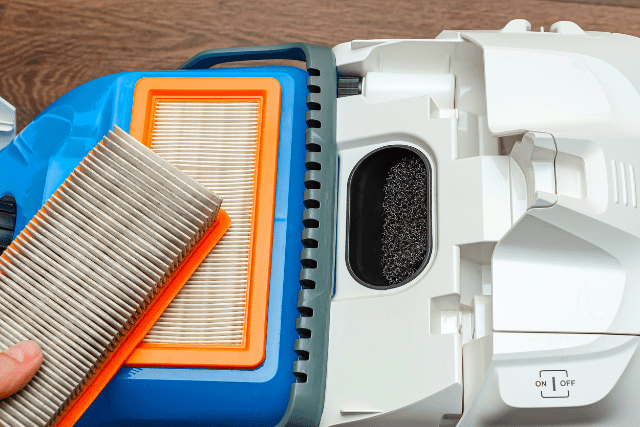
Cleaning HEPA and Disposable Filters
When cleaning HEPA filters, caution should be exercised as they are typically non-washable and should be replaced instead. As for disposable filters, guidelines should be followed to ensure proper cleaning and maintenance.
By taking these precautions and following the recommended methods, the lifespan of disposable filters can be extended, ensuring optimal vacuum performance.
Cautionary notes about cleaning HEPA filters
Caution should be exercised when cleaning HEPA filters to ensure their effectiveness is not compromised.
Here are three cautionary notes to consider when cleaning HEPA filters:
- Avoid washing non-washable HEPA filters as they can damage the filter’s structure and reduce efficiency.
- Follow the manufacturer’s guidelines for cleaning and replacing HEPA filters to maintain effectiveness.
- Be careful not to use harsh cleaning agents or methods that can damage the delicate HEPA filter material. Always ensure the filter is completely dry before reinstalling it in the vacuum cleaner.
Guidelines for cleaning disposable filters
Following specific guidelines for cleaning disposable filters is crucial to clean vacuum filters effectively. Disposable filters should be replaced every six to nine months based on cleaning frequency.
Clean these filters by tapping them against a hard surface to remove debris. If the filter is washable, rinse it under running water and let it air dry completely before reinserting.
Avoid using cleaning solutions on disposable filters to prevent damage. Regularly check and clean disposable filters to maintain optimal vacuum performance.
Methods to extend the lifespan of disposable filters
Regular maintenance and proper cleaning techniques can significantly extend the lifespan of disposable filters in vacuum cleaners. To ensure your filter lasts longer, follow these methods:
- Clean the filter regularly by tapping or brushing off loose dirt and debris.
- Use a second vacuum to remove dust from the filter’s outer and inner surfaces.
- Gently tap the filter against a garbage can to loosen trapped debris.
Changing Vacuum Filters
When maintaining optimal performance, periodically replacing vacuum filters is of utmost importance. This ensures efficient dust and allergen removal, extends the vacuum’s lifespan, and reduces the risk of overheating.
Importance of periodically replacing filters
Periodically replacing filters is crucial for maintaining the optimal performance of your vacuum and ensuring efficient dust and allergen removal.
- Improved suction power: Dirty filters can restrict airflow, leading to reduced suction power and decreased effectiveness of the vacuum. Replacing filters regularly allows you to maintain strong suction and thoroughly clean your floors and surfaces.
- Extended vacuum lifespan: Clogged filters can strain the vacuum motor, causing it to work harder and potentially leading to damage over time. By changing filters periodically, you can prevent excessive wear and tear on the motor, ultimately extending the lifespan of your vacuum.
- Better air quality: Clean filters improve indoor air quality by trapping dust, allergens, and other particles. By replacing filters, you can ensure that the vacuum efficiently removes these pollutants from your home, creating a healthier environment for you and your family.
How to determine when it’s time to change filters
Maintaining optimal vacuum performance and ensuring efficient dust and allergen removal requires knowing when to change filters.
Some key indicators to help you determine when to replace or clean your vacuum filters:
| Indicator | Action |
|---|---|
| Reduced suction power | Clean or replace the filter if you notice decreased suction during vacuuming. |
| Visible dirt and debris accumulation | Inspect the filter for visible dirt and debris, and clean or replace it accordingly. |
| Unpleasant odors | If your vacuum emits a stale smell, it’s a sign that the filter needs cleaning or replacement. |
| Worsened allergies | If you experience worsened allergies after vacuuming, it’s time to clean or replace the filter. |
| Unusual noises | Unusual noises during operation can indicate a dirty or clogged filter that needs attention. |
Step-by-step instructions for replacing different types of filters
To ensure optimal performance, knowing how to properly replace different types of vacuum filters, including HEPA, foam, and disposable filters, is important.
Here are step-by-step instructions for replacing each type:
HEPA Filter:
- Locate the HEPA filter compartment, usually at the back or side of the vacuum.
- Remove the old filter and check for any visible dirt or debris.
- If the filter is washable, rinse it under running water until clean.
- Gently squeeze out excess water and let it air dry completely.
- Once dry, place the filter back into the compartment and secure it properly.
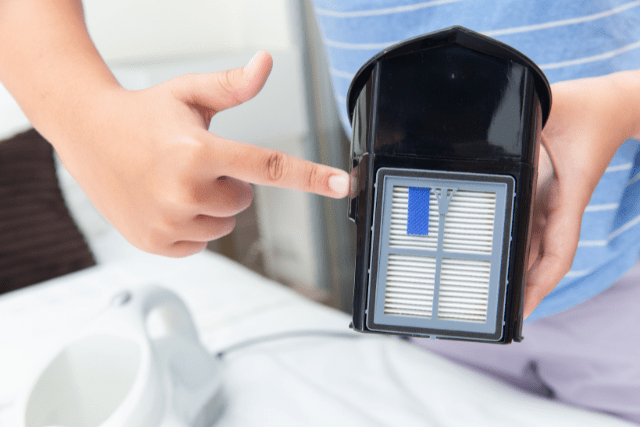
Foam Filter:
- Remove the foam filter from its housing.
- Rinse the filter under hot water to remove dirt and debris.
- Gently squeeze out excess water and allow it to air dry completely.
- Once dry, place the filter back into its housing and secure it properly.
Disposable Filter:
- Remove the disposable filter from its compartment.
- Discard the old filter in a trash bag or according to local disposal guidelines.
- Insert a new disposable filter into the compartment, ensuring it is properly fitted.
These step-by-step instructions will help you maintain optimal performance by regularly replacing and cleaning your vacuum filters.
Maintenance Tips for Optimal Performance
To ensure the optimal performance of your vacuum cleaner, following regular maintenance practices for keeping the filters clean is important. This includes establishing a cleaning schedule based on usage and environment, monitoring suction power for signs of a dirty filter, and using genuine replacement filters recommended by the manufacturer.
Regular maintenance of other components of the vacuum cleaner and avoiding exposure to moisture or damp environments will help maintain a high-performing vacuum cleaner.
Regular maintenance practices to keep vacuum filters clean
Regular maintenance practices are crucial for ensuring vacuum filter cleanliness and optimal performance.
To keep your vacuum filters clean, follow these maintenance tips:
- Regularly clean the filters: Depending on usage and dirt collection, vacuum filters should be cleaned every 3-4 weeks. For high-traffic areas, weekly cleaning is recommended. Cleaning prevents clogging and maintains the vacuum’s efficiency.
- Replace filters as needed: It is recommended to replace vacuum filters every 3-6 months. However, the frequency may vary depending on usage. Regularly inspect the filters for signs of wear and tear and replace them when necessary.
- Follow proper cleaning methods: Different types of filters require specific cleaning methods. Foam filters can be soaked in hot water and gently scrubbed, while cartridge filters can be rinsed and air-dried. Non-washable HEPA filters should be replaced instead.
Frequency of filter cleaning and replacement based on usage and environment
When considering the optimal performance of vacuum filters, it is crucial to determine the frequency of filter cleaning and replacement based on usage and environmental factors. Regular maintenance practices, such as cleaning and replacing filters, ensure vacuums function at their best.
The frequency of filter cleaning depends on how often the vacuum is used and the amount of dirt and debris it collects. Filters should be cleaned every 3-4 weeks to maintain strong suction and efficient dirt removal.
Filters should be replaced every six to nine months, depending on the frequency of cleaning. To help you understand the frequency better, refer to the table below:
| Usage Frequency | Filter Cleaning Frequency | Filter Replacement Frequency |
|---|---|---|
| Daily | Every 2 weeks | Every 6 months |
| 2-3 times/week | Every 3 weeks | Every 7-8 months |
| Once a week | Every 4 weeks | Every 8-9 months |
Additional tips for maintaining a high-performing vacuum cleaner
For optimal performance and longevity of your vacuum cleaner, it is important to follow additional maintenance tips to ensure its high performance.
Here are three additional tips for maintaining a high-performing vacuum cleaner:
- Consider using a vacuum cleaner with a HEPA filter: HEPA filters are designed to improve air quality by trapping small particles and allergens. Using a vacuum cleaner with a HEPA filter can ensure better air quality and reduce the risk of allergies.
- Avoid vacuuming up large debris: Large debris can cause damage to the vacuum filter and affect its suction power. To maintain optimal performance, it is recommended to manually remove large debris before vacuuming or use a broom and dustpan for such tasks.
- Replace damaged filters promptly: If you notice any damage or wear on your vacuum filter, it is important to replace it promptly. Damaged filters can affect the vacuum’s performance and reduce its efficiency in removing dirt and allergens.
Frequently Asked Questions
How Can I Improve My Vacuum Cleaner Performance?
To improve vacuum cleaner performance, regularly clean and change the filters. Dirty filters can reduce suction power and affect air quality. Follow manufacturer guidelines for cleaning frequency and methods, and replace non-washable filters. Proper maintenance extends the vacuum’s lifespan and ensures efficient dust removal.
How Do I Increase the Suction Power of My Vacuum?
To increase the suction power of a vacuum cleaner, cleaning and changing the filters regularly is crucial. Clogged filters can reduce suction, so cleaning them every 3-4 weeks is recommended for optimal performance.
How Do You Clean a Vacuum Filter at Home?
To clean a vacuum filter at home, follow specific methods based on the filter type. Foam filters can be soaked in hot water and gently scrubbed, while cartridge filters require a similar approach. Non-washable HEPA filters should be replaced.
What Can I Put in My Vacuum Filter to Make It Smell Good?
Adding a few drops of essential oil to the vacuum filter can make the room smell pleasant. Essential oils like tea tree, lemongrass, peppermint, and eucalyptus have antibacterial properties and can enhance the scent in the vacuum filter.
Conclusion
Regular cleaning and changing vacuum filters are essential for optimal performance. Neglecting this task can reduce suction power, unpleasant odours, and compromise air quality.
Different types of filters require specific cleaning methods, and HEPA filters should be replaced when necessary. Adhering to a consistent filter maintenance routine ensures efficient removal of dust and allergens while prolonging the vacuum’s lifespan and minimizing the risk of overheating.




